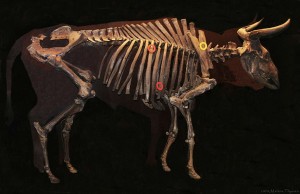 Prehistoric hunters feasted on the bone marrow and juicy ribs of a felled female aurochs on the spot, then butchered the rest and brought it back to the nearby settlement to share with their families. The leftovers of this 7,700-year-old BBQ were discovered in the Tjonger River valley in the Netherlands. Archaeologists from the University of Groningen found the bones and a discarded flint blade.
Prehistoric hunters feasted on the bone marrow and juicy ribs of a felled female aurochs on the spot, then butchered the rest and brought it back to the nearby settlement to share with their families. The leftovers of this 7,700-year-old BBQ were discovered in the Tjonger River valley in the Netherlands. Archaeologists from the University of Groningen found the bones and a discarded flint blade.
The valley’s waterlogged, peaty soil is an excellent preserver of bone, antler and plant remains, and many prehistoric hunting sites, particularly from the Late Mesolithic (ca. 8000–5500 B.C.), have been found in the area. This site is unusual, however, because it preserves a single hunting and butchering instance rather than a collection of them spread out over time. The remains of a single hunt aren’t often discovered because they’re so small and hard to find.
 What the bones tell us about this hunting event is that the quarry was a small female aurochs, only 134 centimeters (approximately 4 feet 5 inches) tall at the withers. They killed her either by trapping her in a pit and clubbing her on the head, or by shooting her with a flint arrow. There’s a well-preserved Mesolithic aurochs skeleton in the National Museum of Denmark from around that time which was killed by arrows (yellow circle marks a healed arrow wound, red circles mark later fatal arrow wounds), and it was a larger specimen than this comparatively small cow. (Look at them ribs!)
What the bones tell us about this hunting event is that the quarry was a small female aurochs, only 134 centimeters (approximately 4 feet 5 inches) tall at the withers. They killed her either by trapping her in a pit and clubbing her on the head, or by shooting her with a flint arrow. There’s a well-preserved Mesolithic aurochs skeleton in the National Museum of Denmark from around that time which was killed by arrows (yellow circle marks a healed arrow wound, red circles mark later fatal arrow wounds), and it was a larger specimen than this comparatively small cow. (Look at them ribs!)
Marks on the bones indicate that after she was brought down, the hunters cut off her legs and ate the marrow. Then they skinned her and carefully removed large sections of meat from the bone.
Burn marks reveal that the hunters cooked the meaty ribs, and probably other smaller parts, over an open fire. They ate them right at the site, “their reward for the successful kill,” Prummel said.
The blade, perhaps worn down from so much cutting, was left behind and wound up slightly scorched in the cooking fire.
Niekus told Discovery News, “The people who killed the animal lived during the Late Mesolithic (the latter part of the middle Stone Age). They were hunter-gatherers and hunting game was an important part of their subsistence activities.”
There is evidence of Mesolithic hunters cooking meat over ground-level fires and in pits. Thousands of these pits, known as hearth-pits, have been found in the Netherlands. Since these communities of hunter-gatherers moved regularly to follow the food sources, they roasted or maybe smoked the meat from their kills to carry with them. Cooked food is easier to preserve and carry, and could be stored for lean times when the hunt was not successful.
The aurochs, a popular albeit challenging target for these peoples due to their delectable size and bad temper, would not survive the habitat loss ushered in by farming and domesticated cattle. They were already scarce in Caesar’s time and the last one died in a Polish zoo in 1627.